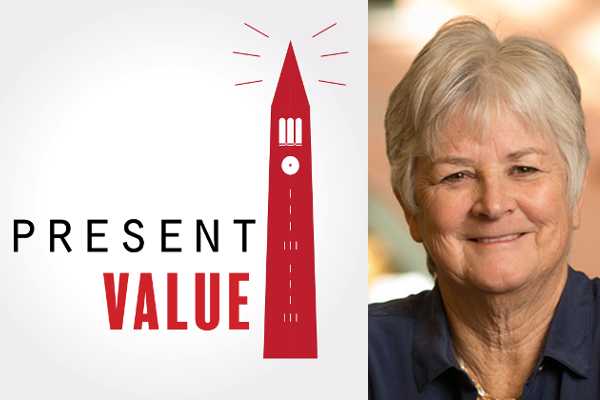Present Value: Maureen O’Hara on market microstructure and ethics on Wall Street

Contributing authors: Cornell MBA students Jonathan Tin, James Feld, Harrison Jobe, and Michael Brady
Present Value, an independent editorial project produced and hosted by Johnson students, had the pleasure of interviewing Maureen O’Hara, the Robert W. Purcell Professor of Finance. Present Value can be streamed on the Present Value website or you can subscribe through iTunes, Apple Podcasts, and other popular podcasting apps by searching for “Present Value.”
Market microstructure—The “plumbing” of markets
Early on in her academic career, Professor O’Hara decided to study market makers (intermediaries between buyers and sellers). “I always thought… if I figure out what market makers do, I’ll be able to figure out what banks do and so I started getting interested in the structure of markets and how they worked,” she said.
Her interest in market makers led to her research on market microstructures and her 1995 classic, Market Microstructure Theory. In some ways, O’Hara “wrote the book” on market microstructure theory, as her book is still used today in graduate courses on the topic. O’Hara explains that market microstructure theory is about how the rules, or design, or “plumbing,” of a market affect liquidity and price discovery.
Her work has been used by institutional investors to design optimal trading algorithms and by regulators to improve market stability. Regulators seek to create rules that engender fair markets, because, as O’Hara said, “If [the markets aren’t] fair, people won’t want to go into them, [which] we saw after the financial crisis; a lot of people got convinced that the markets were rigged and they didn’t want to play anymore and when that happens, it hurts everybody.”
High frequency trading
As the conversation turned to high frequency trading, she explained that high frequency traders have had an overall positive impact on the market by improving liquidity and reducing transaction costs. High frequency traders create liquidity by buying and selling across different markets and have driven down transaction costs due to their high trading volumes. This has enabled all market participants to engage with fairer markets at lower costs.
So what strategy does a market microstructure professor use for her own investments? O’Hara said that she no longer buys mutual funds and has turned to exchange traded funds (ETFs). She explains that ETFs are a better way to transact in the market, compared to mutual funds, because of their liquidity. O’Hara goes on to say, “An ETF is a different beast… you can trade in and out of your ETF all day long, they’re listed on the market just like General Motors or Ford.”
Ethics in finance
O’Hara’s most recent book, Something for Nothing: Ethics and Finance on Wall Street, explores the role of ethics in finance. Just like in her class, she takes the reader and Present Value listeners through nuanced examples that aren’t “so straight forward.” O’Hara explains that, “To me, the interesting questions are … the grey areas. It’s not always obvious where some of these things are, you really need to go back to your principles and what you think should happen.”
In the podcast, O’Hara further discusses the inherent lag in financial regulations and gives examples of actions that may be legal, but that have questionable ethical implications. As she says, “just because it’s legal, doesn’t mean you should do it.”
Do markets need artificial ethics?
While discussing artificial intelligence O’Hara comments, “If a machine’s objective is to make money, then it is not hard to see how the machine could enter into behaviors that are manipulative.” O’Hara describes a hypothetical scenario, where a machine discovers that by introducing volatility into the price of an asset, it can profit. However, introducing volatility into the market could result in prices plummeting. O’Hara thinks that future scenarios such as this, are “not only possible, but likely in markets.”
Traditionally, firms wrote trading algorithms that did not evolve, but today’s genetic algorithms can learn and modify their strategies over time. O’Hara explains that machines, in the pursuit of profits, may enter into “things that are, for all practical purposes, market manipulation.” Pursuing profits through market manipulation, especially by raising volatility, can lead to an unfair market.
Last year, the SEC created new regulations which make firms responsible for the algorithms they develop. But what happens if the algorithm is developed by a machine? O’Hara suggests that regulators may need to marry artificial intelligence to artificial ethics. Regulators may need to create AI rules, which are essentially AI ethics, to preserve fairness in the market. O’Hara admits that it’s not immediately clear how this would be done. She’s working on it.
O’Hara expands on the above topics and more in the full-length episode of Present Value. Listen, subscribe, and share!
About Maureen O’Hara
Maureen O’Hara teaches several popular courses at Cornell, including Financial Markets & Institutions and Finance & Ethics. She is known for her work on market microstructure theory, financial law and ethics, and experimental economics. O’Hara received a BS in economics from the University of Illinois and an MS in economics and PhD in finance from Northwestern University. She was the first woman to serve as the president of the American Finance Association and was the executive editor of the academic journal The Review of Financial Studies.

